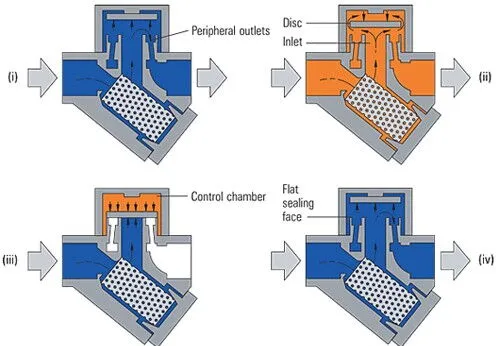In steam systems, steam traps are crucial components that help ensure everything runs smoothly. They automatically remove condensate and air from the system, preventing issues like condensate build-up or air blockages that can affect performance. Properly selecting and maintaining steam traps is essential for keeping equipment efficient and reliable, whether in industrial production or everyday heating systems. In this article, we'll dive into what steam traps do, how to choose the right one, and how correct installation and maintenance can boost system efficiency and extend the lifespan of your equipment.
Steam traps are key players in steam systems. Their main job is to automatically discharge condensate and air, ensuring steam equipment runs efficiently. By removing air and low-temperature condensate, steam traps help equipment reach its ideal operating temperature quickly. This reduces preheating time and improves production efficiency.
Discharging Air: When steam starts flowing, the pipes and equipment are often filled with air. If this air isn't removed, steam can't properly enter the equipment. So, the steam trap's job is to quickly get rid of the air.
Discharging Low-Temperature Condensate: As steam enters the system, it creates condensate that must be drained. If this condensate stays in the system, it can lower heating efficiency and mess with normal operation. The steam trap makes sure that condensate is removed on time, preventing any performance issues.
In intermittent production, a well-functioning steam trap can help reduce downtime, increase processing cycles, and boost overall output. If the steam trap fails, condensate can accumulate, affecting performance and possibly causing a complete shutdown of equipment.

Choosing the right steam trap is key to making sure it works properly. If you pick the wrong one, it might not discharge condensate on time, reduce heating efficiency, or even damage the equipment. Here's what to consider when selecting the right steam trap.
To select the right steam trap, you need to figure out how much condensate it will need to handle. The steam trap's drainage capacity should generally be 2-3 times the steam consumption of the equipment per hour. This is especially important during startup when a large amount of air and condensate needs to be discharged.
How to Calculate: To find the right drainage capacity, take the equipment's steam consumption per hour and multiply it by 2-3 times. This ensures the steam trap can discharge condensate quickly during startup and help the system warm up fast.
The working pressure differential is the difference between the pressure before the steam trap and the back pressure at the outlet. When selecting a steam trap, make sure to base the drainage capacity on the pressure differential rather than just the nominal pressure. This differential directly affects how well the trap can discharge condensate.
Back Pressure Calculation: Back pressure is the pressure at the steam trap outlet. You can calculate it by considering factors like resistance in the return line, the height of the return line, and the pressure in the secondary evaporator. If condensate is directly released into the atmosphere, the back pressure is zero. But if it's recovered, you need to take the return system's pressure into account.
Steam traps come with different specifications based on the working pressure differential range, each having a "valve seat number" that determines the drainage capacity. Picking the right valve seat number is important to make sure the trap works properly. Choosing the wrong number can prevent it from discharging condensate or cause water to build up, affecting system performance.
How to Choose: Consider the maximum working pressure differential and drainage capacity when selecting the valve seat number. Don't just rely on nominal pressure, as this only indicates the valve body's pressure-bearing capacity, not how it interacts with the working pressure differential.
Temperature and pressure changes in the steam system affect the type of steam trap you need. In systems with higher steam temperatures (like superheated steam systems), regular steam traps might not cut it. Special traps designed for high-temperature, high-pressure steam are necessary.
Superheated Steam: When steam is heated beyond its saturation point, it becomes superheated steam. In this case, you need a steam trap designed to handle the higher pressure and temperature.
Different types of steam traps are suited to different situations. Picking the right type ensures your system runs smoothly and efficiently. Here's a breakdown of some common types.
Pulse-type Steam Trap: Good for situations that need fast condensate discharge, but not ideal for low-volume condensate discharge, as steam can escape from the outlet.
Thermostatic Steam Trap: Best for areas that require low noise, like office buildings or schools. These traps work slowly and generate little noise, making them less disruptive.
Float-type Steam Trap: Works well for continuous condensate discharge, such as in steam heating systems. It keeps condensate from building up and helps maintain heating efficiency.
Mechanical Steam Trap: Suitable for high-pressure differential systems that require condensate recovery. These traps handle high back pressure and ensure condensate is efficiently discharged.
Once you've chosen the right steam trap, installation and regular maintenance are essential for keeping it running smoothly.
Installation Tips: Install steam traps at the lowest point of the steam line to make it easier for condensate to flow out. Also, make sure the inlet and outlet directions align with the fluid flow to avoid any installation errors that could disrupt operation.
Maintenance: Regularly check the trap's performance to make sure it's working properly. For mechanical traps, clean the valve seat and piston to prevent scaling or blockages.
Steam traps play a vital role in maintaining steam system efficiency. They help ensure proper heating, prevent equipment damage, and keep everything running smoothly. When choosing a steam trap, consider factors like steam consumption, working pressure differential, steam temperature, and the specific needs of the application. By selecting the right drainage capacity, structure, and performing proper installation and maintenance, you can ensure your steam system operates efficiently and lasts longer.
